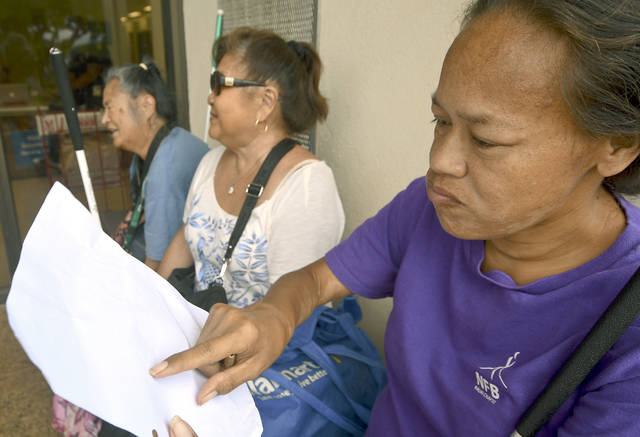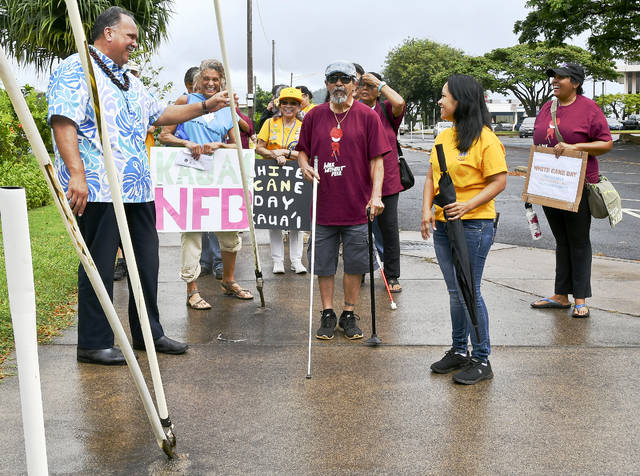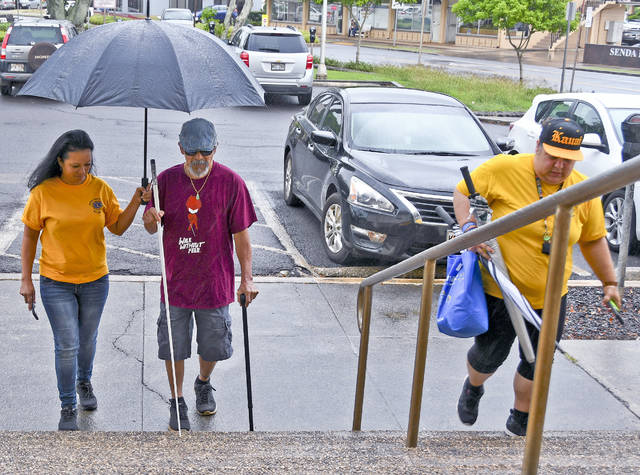LIHUE — Doug Moises of the National Federation of the Blind, Kauai chapter, said to blind people, everyone is beautiful.
“People don’t age when you can’t see them,” Moises said. “Everyone looks good.”
Moises was part of about two dozen people who took part in the White Cane Day walk, hosted by the National Federation of the Blind as a growing spirit of independence and the increased determination to be self reliant.
“The biggest challenge of being blind is not being able to see the grandchildren grow up,” he said.
Moises was blinded in an auto accident in 2006.
“I went to school for the blind where they trained me to be a vendor. Luckily, a space opened up on Kauai, and I have the Dugout snack shop in the Lihue Civic Center, Piikoi Building,” he said.
The White Cane Day walk, supported by the Lions Clubs of Kauai, and others demonstrates the independence by blind and visually impaired people.
“In 1925, Helen Keller challenged the Lions to become ‘Knights of the Blind’ in the crusade against darkness,” said Debi Thompson of the Kauai Lions Club. “Since then, the Lions have worked tirelessly to aid those with visual impairments. Our service area encompasses the entire island of Kauai, and in particular, we are of service to the NFB, Kauai Chapter, assisting with diabetes foot checks, White Cane Day, Vision Van, and more.”
White Cane Day is celebrated Oct. 15 since President Lyndon B. Johnson signed a proclamation in 1963.
Laura Miyashiro of Friendship House said for White Cane Day, the NFB is featuring people who are not blind, but go out of their way to assist the blind and visually impaired.
Shayda Sanay of Anahola became blind from diabetes, noting that the hardest part of not being able to see is spending time with family.
She was being helped by Sheila Thomas, a visually impaired resident from Wailua, in learning how to read in braille while waiting on the walk to start.
“I’m just learning,” Sanay said. “You have to press the paper and I’m only now learning the letters. This says something about White Cane Day.”
As the group moved from the state building and negotiated the sidewalks, pedestrian crosswalks, and Americans of Disabilities Act improvements that are part of the safe streets program, Mayor Bernard Carvalho Jr. saw firsthand how some of the items people take for granted can become hazards for those with special needs.
“This has got to move,” Carvalho said as the group encountered utility pole guide wires and traffic signage sprouting in the middle of the sidewalk. These impediments would normally be avoided by walking around them, but what if you cannot see them?
Priti Tayal of Kapaa was with her mother Trishla Tayal who is legally blind.
“I came home from Philadelphia as a college professor to care for my mom,” Priti said. “This is a day by day thing. It’s been two years since my mother went blind, and I’m still learning. I help my mother daily with tasks when she cannot do it, independently, drive her to her appointments, or grocery shopping, and do whatever needs to be done at home and in the community.”
Trishla became blind from a disease, giant cell arthritis, that affected her retinal artery.
“I cannot see anything from my right eye,” Trishla said. “My left eye has very low vision so legally, I’m blind. The hardest challenge is frustration — not being able to do things I used to do, like driving, and other tasks taking a lot longer to accomplish — and losing the independence of doing things.”
Miyashiro, who attributes her loss of sight to medication needed to treat her mental illness, said she and the National Federation of the Blind appreciates everything everyone does to help the blind and visually-impaired.
“Thank you, Angels to the Blind who live in the dark,” Miyashiro said. “For sharing with us your special skills, abilities, and gifts. Aloha from the National Federation of the Blind, and us disabled and disadvantaged who truly need and appreciate you.”
•••
Dennis Fujimoto, staff writer and photographer, can be reached at 245-0453 or dfujimoto@thegardenisland.com.




